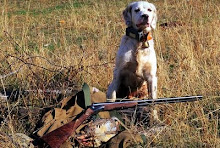 "Speargrass" is a term generally applied to several types of bromes or grasses (also called needlegrass, hayneedle, and foxtail) that produce awns that will create serious problems if ingested or lodged in ears, between the toes, or in the 'armpit' of a dogs. They have very hard, sharp points and barbs that cause them to travel through tissue and migrate through a dog's body. In the areas that I commonly hunt chukars, cheat grass produces awns of this type.
"Speargrass" is a term generally applied to several types of bromes or grasses (also called needlegrass, hayneedle, and foxtail) that produce awns that will create serious problems if ingested or lodged in ears, between the toes, or in the 'armpit' of a dogs. They have very hard, sharp points and barbs that cause them to travel through tissue and migrate through a dog's body. In the areas that I commonly hunt chukars, cheat grass produces awns of this type. Many trainers on the prairies of North America have encountered speargrass during early season training when the awns are still attached to the head of the grasses - about 12 to 18 inches above the ground - exactly where a running dog is likely to get them in its mouth or nose. They can be breathed into the lungs or washed into the stomach from the mouth when a thirsty dog is drinking. Once ingested, they will cause serous illness and slow death. Speargrass has killed a lot of dogs whose problem was not readily diagnosed by veterinarians, except as an unqualified 'infection' or 'foreign body'. A nightmare ailment.
In his book, Bird Dogs and Field Trials, Jack Harper devoted an entire chapter to the dangers of speargrass when running dogs on the prairie. Here are a couple excerpts...
"...Knowing that he must have ingested spears, I decided to autopsy him just to see what spears do when they enter a dog's stomach. I found 22 spears which had already penetrated the stomach wall with only their tails left inside. Although the dog died of stroke, it was more merciful than the painful and lingering death in store for him from the spears."
"A grass needle is an innocent looking thing, but it is one of the most dangerous things in nature for a running dog. The head of the spear is about an inch long with a flexible tail. The point is as hard as steel and as sharp as a sewing needle. From the body are dozens of tiny barbs that slowly and surely work the point forward until it strikes bone.
So sharp is this needle that I have taken one, just to demonstrate to a new helper how sharp they are, and pushed it through the gristle at the edge of a thumbnail. It slides through as though the gristle was soft clay."
Fortunately, forewarned is forearmed, and avoiding speargrass that is still on the heads of the plants is the best (and often ONLY) remedy. In late Summer, after the awns fall from the heads of the plants to the ground, they pose less of a danger to dogs. The timing of their fall to from the plants varies according to moisture and temperature. Better to wait until they are down before running a dog where there is speargrass. Still, you should check your dog's mouth, ears, nose, armpits and between the toes after running. And if he is shaking his head constantly or hacking from a throat obstruction, get him to a vet.









4 comments:
The cheatgrass is bad here in Idaho this year. Had to take a dog to the vet the other day that got one in her ear.
Really scary stuff!
Thanks for the informative post. I knew about eye/ear danger, but not the extent of it.
Thanks for this, Mike. Flesh-eating brambles is about the toughest thing we have to deal with.
Got a book review of that Jack Harper book yet?
best
Andrew
Andrew, I read Harper's book twice now and am considering what I would like to say about him and his book. I'll tackle it when I return from Idaho at the end of next week.
Post a Comment